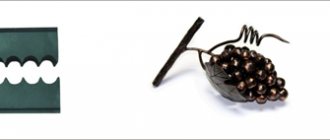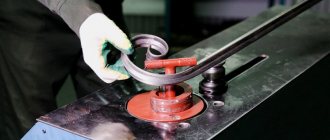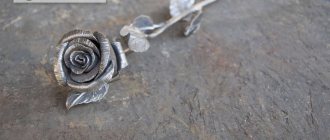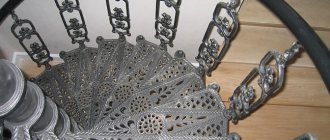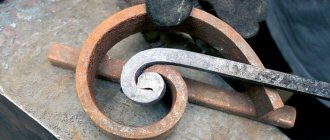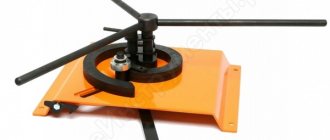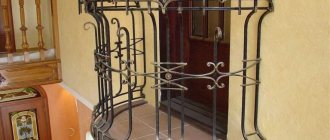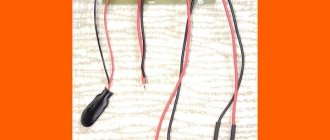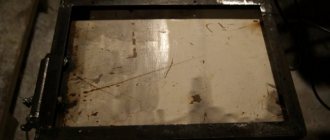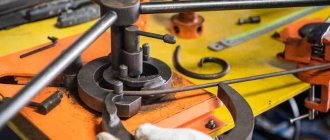Style matching
Forged gazebos, benches, arches and bridges are very popular, as with their help you can add variety and fresh notes to almost any landscape design. These decorative elements allow their authors to bring to life a variety of creative ideas and fantasies.
However, we should not forget about style consistency, which must be carefully observed. The selected samples of forged products should in no way fall out of the general style of the space and the buildings located on it. It is necessary to carefully study the selected samples of artistic forging. Otherwise, the selected element may not fit into the overall picture and look foreign, even if it is very beautiful in itself.
As a rule, wrought iron products go very well with almost any type of landscaping. French parks and English lawns easily accept this style; moreover, such products emphasize their elegance, and sometimes pretentiousness. For the Russian style of designing personal plots, such decorative elements are as typical as, in fact, for the Italian flavor with marble pools and fountains.
An important role here is played by the ornament itself, as well as the number of forged elements in it. The abundance of all kinds of small details, the intricate and lush design is not suitable for every style. The Baroque style is suitable for a plot with a large territory, where the house and other buildings are made in the same style. At the same time, there are no special restrictions for a light and sophisticated product. It fits organically into any design.
Step-by-step cold forging algorithm
Before you start making art objects, it is worth preparing some special equipment and materials.
Equipment for artistic forging
Products are formed using two main processes: pressing and bending. Separately from them, stamping using ready-made templates is used.
This is what most equipment for cold metal processing is built on. The main workbenches that are widely used are: bender, snail, twister, flashlight, globe and wave.
Each of these simple machines works with rolled metal (various bars, circles or squares). Moreover, manual equipment can set the shape of metal blanks with a cross-section of 12-14 millimeters.
What items are produced on these workbenches?
A bender is capable of bending metal at angles or in an arc with one or more turns of the lever. The main elements are various kinds of bends and waves.
The snail, due to the shape of its conductor, twists the workpiece in a spiral. It produces volutes, curls and other elements with spiral turns at the ends.
A twister, on the contrary, twists a long part around its axis. The result is elements with a screwed surface.
Wave making device
Gnutik
The wave is designed for the production of wavy repeating parts. Partially the same operations can be successfully performed on a bend.
The flashlight is similar in principle to a twister, but it makes elements called a basket. These volumetric parts are produced by screwing the workpiece onto a jig in the form of a shaft. The machine may well be replaced by a twister.
A globe or volumetric machine performs various operations to bend the workpiece in different planes, producing three-dimensional parts.
You can make each of these artistic forging machines yourself by searching for the necessary information and drawings.
An example of the simplest manual machine for curls and various types of monograms is shown in the video
In addition to such highly specialized equipment, you will need a tool for cutting metal (cutting wheel or grinder), grinding and welding to assemble parts into a single composition.
Production of artistic forging elements
Most often, the following elements can be found in artistic forging products: monograms, individual curls, waves, baskets and endings in the form of peaks or crow's feet. How to make them using cold forging?
Curls, monograms and volutes
Such elements can often be seen on fences, trellises and similar products.
To make them, you need to have a snail machine, blanks from a rod or square with a cross-section from 8 to 14 mm (depending on the equipment) and, of course, an auxiliary tool for cutting and grinding.
The step-by-step process looks like this.
- The end of the workpiece must be formed to mount the jig on the machine. This is done with heating and preliminary forging or pressing on equipment.
- The prepared edge is inserted into the hole in the conductor and by turning the lever drive, the metal is screwed onto the template. The spiral is made for one turn per approach. Several twists will have to be done in two or three turns.
How to do this is shown in the video provided above. In the absence of such equipment, you can try to make the turns manually. To do this, you need to have a piece of pipe on which, heated with a gas cutter, the part is bent with hammer blows.
Torsion
Various kinds of twists are made on a twister. According to the design, this equipment consists of a gate with a rotating head and a slider with a workpiece lock.
- The rod is fixed in the head and the desired twist length is adjusted using the slider.
- When wrapping the gate, the metal is twisted along the axis all the way to the slide.
The process itself must be carried out carefully, without sudden jerks of the gate, so as not to tear the workpiece, and the spiral is twisted evenly throughout.
Without a twister machine, such an operation can be done manually. The part is heated and, holding one end in a vice, is rotated around the axis with a suitable tool. However, the quality can be much worse.
How such equipment looks and works can be seen in the video:
Baskets
One of the most difficult cold forging elements to manufacture. To produce it, a machine called lanterns is used. Its design is similar to a twister. Only the blanks are wrapped around the template in the form of a shaft.
- Two separate parts are initially inserted into the machine.
- With turns, the gates are twisted into a voluminous spiral.
Also, such a part can be made manually without equipment. A piece of pipe with a place for attaching the end of the rod welded to it is used as a conductor. Having fixed the metal in a vice, it is wound onto the template. The method is more labor-intensive and requires experience. How this is done is shown in the video:
Types of forged products
The most common products that are usually used to decorate the garden area are:
- Fences and gates. They look especially elegant, and sometimes even luxurious. However, they are entrusted with a difficult mission: along with aesthetic functions, they must also perform a protective function.
- Garden furniture (entirely, or with individual forged elements) - its aesthetic qualities, along with strength and durability, will not leave indifferent even the most sophisticated connoisseurs of beauty and elegance.
- Bridges in the garden, decorated with openwork curved patterns, look very elegant, sophisticated and aristocratic. If there is a stream or alpine hill, as well as other exotic vegetation on the site, an element such as a bridge will perform not only a decorative, but also a protective function.
- Stairs and all kinds of supports look very elegant and decorate the porch and terrace.
- Arches and pergolas. Nowadays, they are used not only to create a secluded shady area in which you can relax and enjoy the coolness on a hot summer day. Quite often they act as an independent architectural element. They can be decorated with rose bushes and entwined with vines. That is, they also perform several functions at the same time: aesthetic and practical.
- Barbecues. What would an outdoor holiday be without a barbecue? But not all barbecues fit organically into the surrounding design. Forged barbecues come to the rescue here, adding extraordinary color and comfort to the surrounding space. Here you can show all your imagination, because the process of artistic forging provides for a variety of forms and intricacy of the plot.
- Garden lamps will become the highlight of your garden plot design. All kinds of lanterns decorating the walls of the house and located along the paths will create a romantic mood and bring harmony to the surrounding space.
- Gazebos and canopies. They are usually placed some distance from the house or near a body of water. They serve as a kind of relaxation or privacy area. The airy and light structure evokes a feeling of celebration and puts you in an optimistic mood. A variety of canopies and canopies are designed not only to protect from rain and snow, but also to contribute to the creation of the overall architectural composition.
- Accessories. Flower stands, forged figurines, umbrella holders, garden lamps, door knockers and other items will undoubtedly bring color to drab everyday life. Moreover, these accessories and much more can be made with your own hands.
But is it so easy to make a forged product with your own hands at home?
Types of forging
Many people believe that creating forged products with their own hands is almost impossible. Others believe that there is nothing complicated about it, because blacksmithing has existed for a very long time and our ancestors were successfully engaged in it. However, in order to make even the most simple forged element on your own, you must have certain skills and, preferably, experience in this difficult task. In addition, one cannot do without special tools and knowledge of the properties of various metals.
Hot forging is a labor-intensive and difficult process that is carried out in forges and cannot be done at home.
Without special conditions, an analogue of hot forging is suitable - artistic forging.
Forging stages and techniques
Hot forging includes a large number of techniques used in metal processing. However, the technology itself consists of main stages.
- Heating the workpiece.
- Forging.
- Metal stabilization.
- Hardening (if necessary).
Each individual stage is of great importance. Incorrectly maintained heating temperature of the workpiece will lead to further damage to the product, the same applies to too rapid cooling.
When forging, you also need to follow the technological process, otherwise the workpiece will simply be damaged. At this stage, many techniques are used depending on what product is being made.
Metal stabilization involves gradual cooling of the finished product. This technological stage promotes normal crystallization of highly heated material. The main task is to prevent damage to the internal structure, the appearance of shells and cracks.
Hardening metal in oil
Tempering is used to impart hardness to the finished product by changing the crystal lattice during high temperature heating. Most often in blacksmithing, this stage is carried out when making tools that will experience heavy loads during use. The main requirement for hardening is not to make the metal too brittle (overheat) or, conversely, too soft.
So, how do you forge metal yourself and what techniques are used at each stage of the work?
Product manufacturing process
It will be necessary to create a metal welded structure using rolled metal or metal profiles. Subsequently, it will be decorated with artistic forging details. You will need:
- source of electricity;
- a flat surface suitable for assembling the product;
- grinder with metal brushes, as well as cutting and grinding wheels;
- marker;
- hammer;
- two studs;
- non-stretch rope;
- welding machine;
- mask;
- gloves;
- electrodes.
It is better to use rolled metal with a small cross-section, as it will be easier to bend without the use of special heating. You should select a drawing in advance. Don't choose overly complex designs. Because it is very difficult to work with such a material as metal, especially when doing it for the first time. Metal should be purchased with a (small) reserve, having calculated the need for it in advance. Please note that the length of a standard metal rod is 6 meters.
It is best to process the metal right away , otherwise it will be much more difficult to do it later. It must first be cleaned of rust using a metal brush placed on an angle grinder.
You will then need to assemble the frame using a flat surface for this process. Its size should be calculated based on the external surfaces. There will be a weld at each corner of the frame. First you need to grab one of the sides to avoid skewing the frame. A few drops of welding should be placed on the lower and upper corners, then level the diagonal by tapping on the unwelded corners. Then we weld the remaining two corners.
A drawing on a scale of 1:1 is applied to a pre-prepared flat surface. Using a rope, we measure the elements of the design, applying it to each of them, like a stencil. Thus, we will find out the length to which the metal rods will need to be cut.
To deform the workpieces, you will need the following device: two studs must be welded at a distance of 2-3 cm from each other. With their help and using a hammer, you can bend iron rods, while focusing on the stencil.
When the rods are already bent, you should lay out and assemble the design on the stencil. If there are excess parts, they should be trimmed. After which the product is welded alternately on both sides. Defects and flaws after welding must be carefully cleaned. Decorative forged elements purchased in advance that will decorate the base are welded to the places intended for them. We clean the welding areas again.
For priming, it is best to use white primer, since all the flaws are visible on it. The paint must have the same properties as the primer. Artificial aging or gilding will add a special chic to the product, which will look very similar to forged.
For those who have already become proficient in this matter, the products they produce are simply magnificent.
Caring for forged products
Forged products, like any other, need care . Being located on the street, they are exposed to various environmental influences, which negatively affects their appearance. It is advisable to paint them once every 2-3 years. It is imperative to lubricate the rubbing parts of gates, swings and gates. This way they will last much longer.
To summarize, it should be noted that everything ingenious is simple, as the famous proverb says. If you want to decorate your backyard yourself, you should bring it to life as quickly as possible. Hand-made forged products will help create a cozy and friendly atmosphere and bring bright colors to everyday life.
